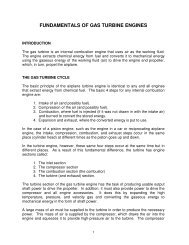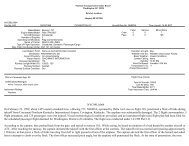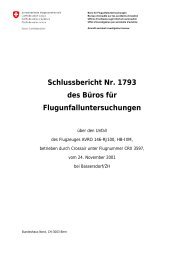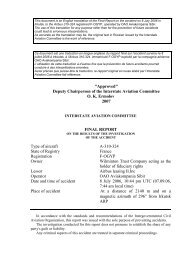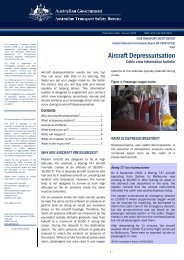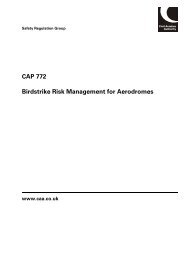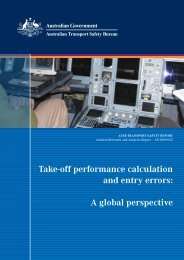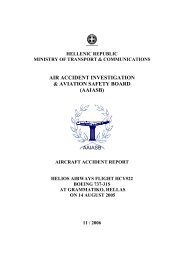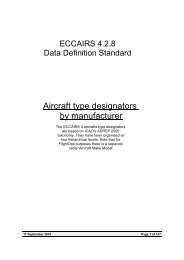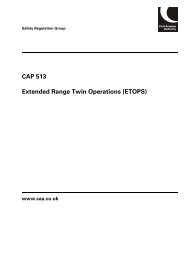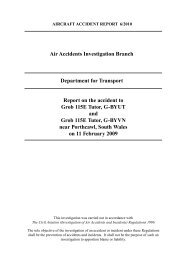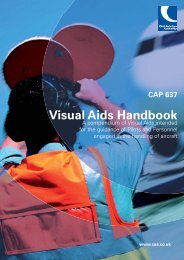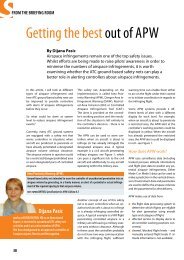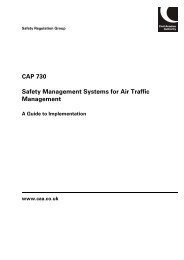OPS OPS 1 - Skybrary
OPS OPS 1 - Skybrary
OPS OPS 1 - Skybrary
You also want an ePaper? Increase the reach of your titles
YUMPU automatically turns print PDFs into web optimized ePapers that Google loves.
Level Bust Briefing Notes<br />
Aircraft Operators<br />
<strong>OPS</strong> 1<br />
Standard Operating Procedures<br />
1. Introduction<br />
1.1. Adherence to standard operating procedures<br />
(SOPs) is an effective method of preventing level<br />
busts, including those that lead to controlled flight<br />
into terrain (CFIT).<br />
1.2. Crew resource management (CRM) is not<br />
effective without adherence to SOPs.<br />
2. Manufacturer's SOPs<br />
2.1. SOPs published by an aircraft manufacturer are<br />
designed to:<br />
(a) Reflect the manufacturer's flight deck design<br />
philosophy and operating philosophy;<br />
(b) Promote optimum use of aircraft design<br />
features; and,<br />
(c) Apply to a broad range of company operations<br />
and environments.<br />
2.2. The initial SOPs for a new aircraft model are<br />
based on the manufacturer's objectives and on<br />
the experience acquired during flight-testing<br />
programs and route-proving programs.<br />
2.3. After they are introduced into service, SOPs are<br />
reviewed periodically and are improved based on<br />
feedback received from users (in training and in<br />
line operations).<br />
3. Customised SOPs<br />
3.1. An aircraft manufacturer's SOPs can be adopted<br />
by a company without amendment, or can be<br />
used to develop customised SOPs.<br />
3.2. Changes to the airframe manufacturer's SOPs<br />
should be co-ordinated with the manufacturer and<br />
should be approved by the appropriate authority.<br />
3.3. SOPs must be clear and concise; expanded<br />
information should reflect the company's operating<br />
philosophy and training philosophy.<br />
3.4. The Flight Safety Foundation (FSF) developed a<br />
Standard Operating Procedures Template 1<br />
adapted from the Federal Aviation Administration<br />
(FAA) Advisory Circular 120-71 – Standard<br />
Operating Procedures for Flight Deck<br />
Crewmembers. Appendix 1 to JAR-<strong>OPS</strong> 1.1045,<br />
Section 8 lists matters that should be the subject<br />
of SOPs but does not include a comparable SOP<br />
template.<br />
3.5. The FSF template is a valuable aid in developing<br />
company SOPs, but operators should be aware of<br />
the differences between FARs and JAR-<strong>OPS</strong><br />
when using this document. Company SOPs are<br />
usually developed to ensure standardisation<br />
among different aircraft fleets operated by the<br />
company.<br />
3.6. Company SOPs should be reassessed<br />
periodically, based on revisions of the airframe<br />
manufacturer's SOPs and on internal company<br />
feedback, to identify any need for change.<br />
3.7. Flight crews and cabin crews should participate<br />
with flight standards personnel in the development<br />
and revision of company SOPs to:<br />
(a) Promote constructive feedback; and,<br />
(b) Ensure that the SOPs, as well as the reasons<br />
for their adoption, are fully understood by<br />
users.<br />
4. Scope of SOPs<br />
4.1. The primary purpose of SOPs is to identify and<br />
describe the standard tasks and duties of the flight<br />
crew for each flight phase.<br />
4.2. SOPs are generally performed from memory, but<br />
tasks related to the selection of systems and to<br />
the aircraft configuration should be cross-checked<br />
using normal checklists.<br />
4.3. SOPs are usually supplemented by information<br />
about specific operating techniques or by<br />
1 Flight Safety Foundation Standard Operating Procedures<br />
Template – see FSF ALAR Toolkit, pages 6-8<br />
EUROCONTROL Safety Enhancement Business Division – Directorate of ATM Programmes
(d) Standard calls – standard phraseology and<br />
recommendations for specific types of operations<br />
3 See also Briefing Note <strong>OPS</strong> 2 – Altimeter Setting Procedures.<br />
(e.g. operation on wet runways or contaminated<br />
terms used for effective crew communication.<br />
runways, extended-range twin-engine operations<br />
[ET<strong>OPS</strong>] and/or operation in reduced vertical Standardisation<br />
separation minima [RVSM] airspace).<br />
5.3. SOPs are the reference for crew standardisation<br />
4.4. SOPs assume that all aircraft systems are<br />
operating normally and that all automatic functions<br />
are used normally. (A system may be partially<br />
inoperative or totally inoperative without affecting<br />
and establish the working environment required<br />
for CRM.<br />
Task-sharing<br />
the SOPs.)<br />
5.4. The following guidelines apply to any flight phase<br />
4.5. SOPs should emphasise the following items:<br />
but are particularly important to the high-workload<br />
climb-out and approach-and-landing phases.<br />
(a) Operating philosophy;<br />
(b) Task-sharing;<br />
5.5. The pilot flying (PF) is responsible for controlling<br />
the horizontal flight path and the vertical flight<br />
path, and for energy management, by:<br />
(c) Optimum use of automation;<br />
(a) Supervising autopilot operation and<br />
(d) Sound airmanship;<br />
autothrottle operation (maintaining awareness<br />
of the modes armed or selected, and of mode<br />
(e) Standard calls 2 ;<br />
(f) Normal checklists;<br />
(g) Briefings;<br />
(h) Altimeter-setting and cross-checking<br />
changes); or,<br />
(b) Hand-flying the aircraft, with or without flight<br />
director (FD) guidance, and with an<br />
appropriate navigation display (e.g., horizontal<br />
situation indicator [HSI]).<br />
procedures 3 ;<br />
(i) Descent profile management;<br />
(j) Energy management;<br />
(k) Terrain awareness;<br />
5.6. The pilot not flying (PNF) (pilot monitoring) is<br />
responsible for monitoring tasks and for<br />
performing the actions requested by the PF; this<br />
includes:<br />
(a) Performing the standard PNF tasks:<br />
(l) Radio altimeter;<br />
− SOP actions; and,<br />
(m) Level bust awareness.<br />
− FD and flight management system (FMS)<br />
mode selections and target entries (e.g.<br />
5. General Principles<br />
altitude, airspeed, heading, vertical speed,<br />
etc.), when the PF is hand- flying the aircraft;<br />
5.1. SOPs should contain safeguards to minimise the<br />
potential for inadvertent deviations from SOPs,<br />
(b) Monitoring systems and aircraft configuration;<br />
particularly when operating under abnormal<br />
and,<br />
conditions or emergency conditions, or when<br />
(c) Cross-checking the PF to provide backup as<br />
interruptions/distractions occur.<br />
required (this includes both flight operations<br />
5.2. Safeguards include:<br />
(a) Action blocks – groups of actions being<br />
and ground operations).<br />
Automation<br />
accomplished in sequence;<br />
5.7. With higher levels of automation, flight crews have<br />
(b) Triggers - events that initiate action blocks;<br />
more options and strategies from which to select<br />
for the task to be accomplished.<br />
(c) Action patterns – instrument panel scanning<br />
sequences or patterns supporting the flow and<br />
5.8. Company SOPs should define accurately the<br />
sequence of action blocks; and,<br />
options and strategies available for the various<br />
phases of flight and for the various types of<br />
approach.<br />
2 See Briefing Note <strong>OPS</strong> 3 – Standard Calls
Level Bust Briefing Notes<br />
Aircraft Operators<br />
Briefings<br />
5.9. The importance of briefing techniques is often<br />
underestimated, although effective briefings<br />
enhance crew standardisation and<br />
communication.<br />
5.10. An interactive briefing style – e.g. confirming the<br />
agreement and understanding of the pilot not<br />
flying (PNF) after each phase of the briefing – will<br />
provide a more effective briefing than an<br />
uninterrupted recitation terminated by a final<br />
query, “Any questions?”<br />
5.11. An interactive briefing fulfils two important<br />
purposes:<br />
(a) To provide the pilot flying (PF) and PNF with<br />
an opportunity to correct each other; and,<br />
(b) To share a common mental image of the<br />
phase of flight being briefed.<br />
5.12. The briefing should be structured (i.e. follow the<br />
logical sequence of the departure, approach and<br />
landing, etc.) and concise.<br />
5.13. Routine and formal repetition of the same<br />
information on each flight may become<br />
counterproductive; adapting and expanding the<br />
briefing by highlighting the special aspects of the<br />
departure or approach, or the actual weather<br />
conditions, will result in more effective briefings.<br />
5.14. Whether anticipated or not, changes in an ATC<br />
clearance, weather conditions, or runway in use<br />
require a partial review of the briefing.<br />
6. Training<br />
6.1. Disciplined use of SOPs and normal checklists<br />
should begin during transition training, because<br />
habits and routines acquired during transition<br />
training have a lasting effect.<br />
6.2. Transition training and recurrent training provide a<br />
unique opportunity to discuss the reasons for<br />
SOPs and to discuss the consequences of failing<br />
to adhere to them.<br />
6.3. Conversely, allowing deviations from SOPs and/or<br />
normal checklists during initial training or recurrent<br />
training may encourage deviations during line<br />
operations.<br />
7. Deviations from SOPs<br />
7.1. To ensure adherence to published SOPs, it is<br />
important to understand why pilots intentionally or<br />
inadvertently deviate from SOPs.<br />
7.2. In some intentional deviations from SOPs, the<br />
procedure that was followed in place of the SOP<br />
seemed to be appropriate for the prevailing<br />
situation.<br />
7.3. The following factors and conditions are often cited in<br />
discussing deviations from SOPs:<br />
(a) Inadequate knowledge or failure to understand<br />
the procedure (e.g., wording or phrasing was<br />
not clear, or the procedure was perceived as<br />
inappropriate);<br />
(b) Insufficient emphasis during transition training<br />
and recurrent training on adherence to SOPs;<br />
(c) Inadequate vigilance (e.g. fatigue);<br />
(d) Interruptions (e.g. communication with air<br />
traffic control);<br />
(e) Distractions (e.g., flight deck activity);<br />
(f) Task saturation;<br />
(g) Incorrect management of priorities (e.g., lack<br />
of a decision-making model for time-critical<br />
situations);<br />
(h) Reduced attention (tunnel vision) in abnormal<br />
conditions or high-workload conditions;<br />
(i) Inadequate CRM (e.g., inadequate crew coordination,<br />
cross-check and backup);<br />
(j) Company policies (e.g., schedules, costs, goarounds<br />
and diversions);<br />
(k) Other policies (e.g., crew duty time);<br />
(l) Personal desires or constraints (e.g.,<br />
schedule, mission completion);<br />
(m) Complacency; and,<br />
(n) Overconfidence.<br />
7.4. These factors may be used to, assess company<br />
exposure to deviations and/or personal exposure<br />
to deviations, and to develop corresponding<br />
methods to help prevent deviations from SOPs.<br />
8. Summary<br />
8.1. Deviations from SOPs occur for a variety of<br />
reasons; intentional deviations and inadvertent<br />
deviations from SOPs have been identified as<br />
causal factors in many level bust incidents.<br />
8.2. CRM is not effective without adherence to SOPs,<br />
because SOPs provide a standard reference for<br />
the crew’s tasks on the flight deck. SOPs are<br />
effective only if they are clear and concise.<br />
EUROCONTROL Safety Enhancement Business Division – Directorate of ATM Programmes
8.3. Transition training provides the opportunity to<br />
establish the disciplined use of SOPs, and<br />
recurrent training offers the opportunity to<br />
reinforce that behaviour.<br />
9. Resources<br />
Other Level Bust Briefing Notes<br />
9.1. The following Level Bust Toolkit Briefing Notes<br />
contain information to supplement this discussion:<br />
GEN 2 – Pilot-Controller Communications;<br />
<strong>OPS</strong> 2 – Altimeter Setting Procedures;<br />
<strong>OPS</strong> 3 – Standard Calls;<br />
<strong>OPS</strong> 4 – Aircraft Technical Equipment;<br />
<strong>OPS</strong> 5 – Airborne Collision Avoidance Systems.<br />
Access to Resources<br />
9.2. Most of the resources listed may be accessed free<br />
of charge from the Internet. Exceptions are:<br />
ICAO documents, which may be purchased direct<br />
from ICAO;<br />
Certain Flight Safety Foundation (FSF)<br />
Documents, which may be purchased direct from<br />
FSF;<br />
Certain documents produced by the Joint Aviation<br />
Authorities, which may be purchased from JAA.<br />
Regulatory References<br />
9.3. Documents produced by regulatory authorities<br />
such as ICAO, JAA and national aviation<br />
authorities are subject to amendment. Reference<br />
should be made to the current version of the<br />
document to establish the effect of any<br />
subsequent amendment.<br />
ICAO Annex 6 Part I Appendix 2 – Contents of an<br />
Operations Manual;<br />
ICAO Doc 8168 – Procedures for Air Navigation<br />
Services – Operations (PANS-<strong>OPS</strong>);<br />
ICAO Doc 9376 – Preparation of an Operations<br />
Manual;<br />
JAR-<strong>OPS</strong> 1.1040 – Sub-part P and associated<br />
AMCs and IEMs – General Rules for Operations<br />
Manuals;<br />
JAR-<strong>OPS</strong> 1.1045 – Sub-part P and associated<br />
AMCs and IEMs – Operations Manual – Structure<br />
and Contents.<br />
Training Material – Safety Letters<br />
EUROCONTROL Safety Letter – Level Bust: a<br />
Shared Issue?;<br />
EUROCONTROL Safety Letter – Reducing Level<br />
Bust;<br />
EUROCONTROL Safety Letter – En Route to<br />
Reducing Level Bust;<br />
EUROCONTROL Safety Letter – Airborne<br />
Collision Avoidance Systems (ACAS);<br />
EUROCONTROL ACAS II Bulletin: “Follow the<br />
RA!”;<br />
Training Material – Posters<br />
Level Bust Prevention posters produced by<br />
the UK CAA:<br />
2 Many Things;<br />
Low QNH – High Risk;<br />
No Rush – No Mistake;<br />
Wun Wun Zero.<br />
Other Training Material<br />
FAA Advisory Circular 120-71 – Standard<br />
Operating Procedures for Flight Deck<br />
Crewmembers;<br />
Flight Safety Foundation (FSF) Approach and<br />
Landing Accident Reduction (ALAR) Toolkit<br />
Briefing Note:<br />
1.3 – Operations Golden Rules;<br />
1.4 – Standard Calls;<br />
1.6 – Approach and Go-around Briefings.<br />
FSF Accident Prevention 1/99 – Aircraft Accidents<br />
Aren’t – Part 2;<br />
FSF Accident Prevention 12/95 – Different<br />
Altimeter Displays and Crew Fatigue …;<br />
FSF Accident Prevention 4/98 – Boeing 737 Pilot<br />
selects Incorrect Altitude in Holding Pattern….<br />
Other Resources<br />
FSF Digest 7/94 – Sterile Cockpit Compliance;<br />
FSF Digest 12/95 – Altitude Awareness Programs<br />
Can Reduce Altitude Deviations;
Level Bust Briefing Notes<br />
Aircraft Operators<br />
FSF Digest 3/99 – Enhancing Flight Crew<br />
Monitoring Skills;<br />
NASA article – What Goes Up Must Come Down;<br />
UK CAA CAP 710 – “On the Level” &<br />
Recommendations.<br />
© European Organisation for Safety of Air Navigation (EUROCONTROL) June 2004.<br />
This briefing note has been prepared by the Safety Improvement Sub-Group (SISG) of EUROCONTROL to help prevent level busts.<br />
It is one of 14 briefing notes that form a fundamental part of the European Air Traffic Management (EATM) Level Bust Toolkit.<br />
The authors acknowledge the assistance given by many sources, particularly Airbus Industrie and the Flight Safety Foundation (FSF),<br />
in developing these notes, some of which draw on material contained in the<br />
FSF Approach and Landing Accident Reduction (ALAR) Toolkit.<br />
The information contained in this document may be copied in whole or in part, providing that the<br />
copyright notice and disclaimer are included.<br />
The information contained in this document may not be modified without prior permission from EUROCONTROL.<br />
EUROCONTROL makes no warranty, either implied or expressed, for the information contained in this document, neither does it<br />
assume any legal liability or responsibility for the accuracy completeness and usefulness of this information.<br />
EUROCONTROL Safety Enhancement Business Division – Directorate of ATM Programmes



